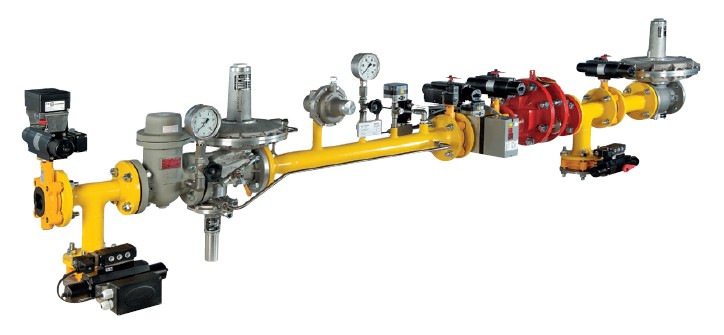The gas train is a vital and often underappreciated component in combustion systems that power a multitude of industrial applications. It serves as the central assembly responsible for safely and efficiently delivering the appropriate amount of fuel to the burner. Whether it’s industrial furnaces, boilers, or gas-fired ovens, gas trains are the unsung heroes that ensure precise control, safety, and optimal combustion. In this comprehensive 1000-word article, we will delve into the world of gas trains, exploring their significance, components, functionality, applications, and the pivotal role they play in combustion systems.
The Significance of Gas Trains
In the realm of combustion systems, gas trains hold immense significance due to various reasons:
Safety: Gas trains are meticulously designed to ensure the safe and controlled supply of fuel. They play a pivotal role in preventing gas leaks, over-pressurization, and other potential hazards.
Efficiency: These systems are built to optimize the combustion process, ensuring that the precise amount of fuel is delivered to meet the demand. This reduces waste and improves energy efficiency.
Precision Control: Gas trains offer precise control over the fuel-to-air ratio, which is essential for maintaining consistent and efficient combustion.
Versatility: Gas trains can be customized to fit various burner types, fuel sources, and industrial applications, making them adaptable for a wide range of industries.
The Role of Gas Trains
Gas trains are the heart of combustion systems, performing a multitude of essential functions, including:
Fuel Supply: They regulate the supply of gas, ensuring that it meets the burner’s requirements in terms of pressure, flow rate, and quality.
Safety Measures: Gas trains incorporate numerous safety features, such as gas pressure switches, solenoid valves, and flame detectors, to prevent accidents, equipment damage, and ensure safety.
Flow Control: Gas trains allow for precise adjustment of the fuel-to-air ratio, optimizing combustion for maximum efficiency.
Remote Operation: Many gas trains can be integrated into automated systems for remote control and monitoring, which enhances safety and convenience.
Components of a Gas Train
A typical gas train comprises various components, each serving a specific role in the combustion process. Some of the key components include:
- Manual Shutoff Valve: This valve enables manual control over gas flow and is typically the first point of control.
- Pressure Regulator: Pressure regulators maintain a consistent gas pressure in the train, ensuring a stable supply to the burner.
- Gas Filter: Gas filters remove impurities and contaminants from the fuel, improving the quality of the gas before combustion.
- Safety Shutoff Valve: A solenoid valve or motorized valve that can quickly shut off the gas supply in case of an emergency or malfunction.
- Gas Pressure Switch: Gas pressure switches monitor the gas pressure and can trigger the safety shutoff valve if the pressure deviates from the acceptable range.
- Gas Pressure Gauge: Pressure gauges display the current gas pressure within the system, allowing for manual monitoring.
- Vent Valve: Vent valves allow excess gas to be released safely, preventing over-pressurization in the system.
- Flame Detector: In some combustion systems, flame detectors are included to ensure the presence of a flame. If the flame goes out, the gas supply is shut off.
- Gas Valve Proving System: This system verifies the proper closure of the safety shutoff valve and ensures it functions correctly.
- Control Panel: Control panels house electrical components, such as switches and indicators, for monitoring and controlling the gas train.
Applications Across Industries
Gas trains find applications across various industries where combustion systems are used. Some of the key sectors include:
- Industrial Furnaces: Industrial furnaces rely on gas trains to control the flow of fuel for processes like metal smelting and heat treating.
- Boilers: Gas trains are commonly used in steam boilers for heating and power generation.
- Commercial Ovens: Gas-fired ovens in bakeries, restaurants, and food production facilities depend on gas trains for their operation.
- Incinerators: Waste disposal and environmental facilities use combustion systems with gas trains to efficiently dispose of waste.
- Chemical Processing: The chemical manufacturing industry utilizes gas trains for the precise control of combustion processes.
- Power Plants: Combustion systems in power generation plants rely on gas trains for fuel supply.
- Refineries: Gas trains are used to maintain efficient combustion in the refining of crude oil.
Advantages of Gas Trains
Gas trains offer numerous advantages for industries and consumers alike:
Safety: They incorporate multiple safety features to prevent gas leaks, over-pressurization, and other hazards, ensuring a safe working environment.
Efficiency: Gas trains optimize combustion processes, reducing waste and improving energy efficiency.
Precision Control: They allow for precise adjustment of the fuel-to-air ratio, ensuring consistent and efficient combustion.
Versatility: These systems can be customized for different applications, making them adaptable for various industries and processes.
Remote Operation: Many gas trains can be integrated into automated systems for remote control and monitoring, enhancing safety and convenience.
Choosing the Right Gas Train
Selecting the appropriate gas train is crucial to ensure the safe and efficient operation of combustion systems. Key considerations include:
Application: Consider the specific requirements of your application, including fuel type, burner type, and combusion process.
Safety Features: Ensure that the gas train includes the necessary safety features to prevent accidents and equipment damage.
Capacity: Determine the capacity of the gas train to meet the demand of your combustion system.
Compatibility: Ensure compatibility with your existing equipment, including burners and control systems.
Regulatory Compliance: Verify that the gas train complies with industry standards and regulations for safety and performance.
The Future of Gas Trains
The future of gas trains is promising, with advancements in materials, design, and automation. These systems are expected to become more sophisticated, allowing for seamless integration into smart and automated combustion control systems. Their role in ensuring safety and efficiency in combustion processes will remain pivotal.
In conclusion, gas trains are the unsung heroes that ensure the safe and efficient delivery of fuel to burners, playing a vital role in a wide range of industrial applications and processes.











